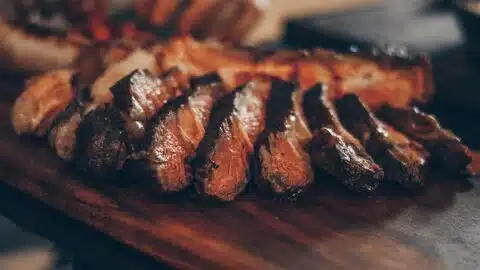When it comes to the realm of steaks, preferences can differ drastically. Some folks are all about the robust, beefy flavours of a rib eye, while others swoon over the tenderness of a fillet. Then some vouch for the flat iron steak’s balance between flavour and texture. So, which is truly the best – rib eye, fillet, or flat iron steak?
We will take you on a culinary journey exploring these popular steak cuts steak in London that we serve at Americana. We’ll cover everything from their origins on the cow to the best cooking methods and the taste and texture that makes each one unique. So, let’s dive in!
Decoding the Rib Eye Steak
Where Does Rib Eye Steak Come From?
A ribeye steak originates from the rib section of a cow, typically cut from the 6th to the 12th rib. This region is known for its abundant marbling, contributing to the steak’s rich flavour and tenderness.
The Taste and Texture of Rib Eye Steak
The characteristic feature of a ribeye steak is its high-fat content, which imparts a pronounced buttery flavour that steak enthusiasts revere. The steak’s marbling melts as it cooks, permeating the meat with a juiciness that’s hard to resist.
How to Cook a Rib Eye Steak
Rib eye steaks excel when seared on our hot grill or skillet, then finished on medium heat. They are best cooked to medium-rare or medium, allowing the marbling to render without overcooking the steak.
Unravelling the Fillet Steak
Where Does Fillet Steak Come From?
Also known as filet mignon, fillet steak is cut from the tenderloin, a section of the cow that sees little activity. This lack of movement makes the fillet steak the most tender cut of beef available.
The Taste and Texture of Fillet Steak
Although fillet steaks can’t compete with the robust flavour of rib eyes, they offer a subtly rich taste. Their low-fat content makes them less juicy, but their unparalleled tenderness is a trade-off many are willing to make.
How to Cook a Fillet Steak
Our chefs at Americana find grilling or pan-frying are the most suitable cooking methods for a fillet steak. Quick, high-heat cooking is key to preventing drying out this lean cut. It’s best served rare to medium-rare to maintain its tender texture.
Flat Iron Steak
Where Does Flat Iron Steak Come From?
Flat iron steaks are cut from a cow’s shoulder or chuck area, specifically the top blade muscle. Despite their location, flat iron steaks are surprisingly tender and flavourful.
The Taste and Texture of Flat Iron Steak
Flat iron steaks may not be as fatty as rib eyes, but they still pack a rich, beefy punch. They’re leaner yet tender, making them an ideal choice for those who prefering less fatty steak.
How to Cook a Flat Iron Steak
Our chefs find this steak is best cooked hot and fast on a grill. It’s important not to cook it beyond medium, as the muscular structure can make it chewy if overcooked.
Rib Eye, Fillet, or Flat Iron Steak: Which Steak in London Is Best?
The rib eye steak is your best bet if you seek a robust flavour and don’t mind a little extra fat. The fillet steak comes out on top if tenderness is your primary measure. However, the flat iron steak is a worthy contender if you’re after a balance between flavour, tenderness, and cost.
Choosing the best steak ultimately boils down to your personal preferences and budget. Now that you know, you can make an informed decision the next time you’re at Americana London; our staff are also very happy to discuss your steak requirements!
Frequently asked questions about Which Steak in London Reigns Supreme?
Is rib eye a better cut than sirloin?
- Ribeye Steak: The ribeye comes from the rib area of the cow, which is less used and, therefore, very tender. It has more marbling (fat distribution within the muscle), which imparts a richer, buttery flavour to the meat when cooked. This cut is generally more expensive due to its marbling and tenderness.
- Sirloin Steak: The sirloin comes from the back of the cow, a little more worked muscle group, which can make it slightly less tender than a ribeye, but it’s still one of the more tender cuts compared to, say, a rump or a round steak. Sirloin steaks are leaner than ribeye steaks with less marbling, which can result in a more meaty flavour and less fat. They are also usually less expensive.
So, if you enjoy a richer, fattier steak, you might prefer a ribeye. If you like a leaner, meatier steak, a sirloin might be your preference. However, both are excellent cuts of meat that can be cooked in various ways to deliver delicious results.
What cut is ribeye?
A ribeye steak is cut from the rib section of a cow, specifically from the muscle that runs along the back of the cow close to the spine, part of which extends into the steer’s rib section. This muscle area doesn’t get much exercise, so the meat here stays particularly tender.
The ribeye is between the chuck and the short loin (where T-bone, porterhouse, and club steaks come from). A ribeye steak and a prime rib roast come from this area, but they are cut and cooked differently.
What sets the ribeye apart is its marbling, or the streaks of fat interspersed with the lean meat. The marbling melts during cooking, making the ribeye juicy and flavoured. A special kind of ribeye steak, known as a ribeye cap steak, comes from the most tender part of the ribeye, and it’s often considered the most desirable cut.
Is ribeye better than fillet?
Whether ribeye is “better” than filet mignon (beef tenderloin) depends on your personal preferences, as both are high-quality cuts of steak with different characteristics:
- Ribeye Steak: Ribeye steaks are known for their rich, robust flavour. This comes from their high degree of marbling, or fat distributed throughout the meat. When cooked, the marbling melts, leading to a juicy, flavorful steak. The texture is tender, but it has some chew compared to a filet mignon. Ribeye steaks are usually boneless but can be served bone-in for additional flavour.
- Filet Mignon (Beef Tenderloin): Filet mignon is known for its extreme tenderness—it’s one of the most tender cuts of beef. However, it has less fat marbling than a ribeye, so while it’s very tender, it may not have as much inherent flavour. Because of this, it’s often served with sauces or accompaniments that complement its mild flavour. Filet mignon is also typically more expensive than ribeye.
So, you might prefer filet mignon if you prioritise tenderness and a mild flavour (often to be complemented with a sauce). If you value a bold, beefy flavour and don’t mind a bit more chewiness, you might prefer a ribeye. Both cuts are very versatile and can be prepared in several ways to enhance their unique characteristics.
What cut is poor man’s ribeye?
“Poor Man’s Ribeye” is a term often used to refer to a Chuck Eye Steak. This cut of beef is known for its rich, beefy flavour that is similar to a Ribeye Steak but at a fraction of the cost, hence the name.
While not as tender or as marbled as a Ribeye, the Chuck Eye is a flavorful cut that can be a great alternative for those seeking a more affordable steak. As with any piece of beef, the key to a good result is to cook it properly, and in the case of a Chuck Eye, medium-rare to medium is typically recommended.
Is fillet steak a good steak?
- Tenderness: The filet mignon comes from the tenderloin, a muscle that receives very little exercise, which makes it extremely tender. It’s often described as “buttery” or “melt-in-your-mouth” because of this tenderness.
- Lean: Filet mignon is a very lean cut of beef, meaning it has less fat marbling than other cuts like ribeye or sirloin. While this may mean it has slightly less flavour (as fat contributes to flavour), it’s often appreciated by those who prefer a leaner steak.
- Versatility: Filet mignon can be cooked in a variety of ways, including pan-searing, grilling and broiling. It’s often wrapped in bacon to add fat and flavour or served with rich sauces to complement its mild flavour.
- Expensive: The tenderloin is a small, elongated muscle that runs along both sides of the cow’s spine, which means there isn’t a lot of it — making it rare and thus more expensive.
Do you cook fillet steak in oil or butter?
Oil or butter can be used when cooking a filet mignon steak, and they each offer distinct benefits:
Cooking with Oil: Using oil, particularly oils with high smoke points like rape seed oil, canola or grapeseed oil, is a good way to start when searing a steak. The oil helps to create a nice, even crust on the outside of the steak, start with a small amount of oil in a hot pan and then adding the steak.
Cooking with Butter: Butter is often used towards the end of cooking to add flavour. When the steak is nearly done, you can add a few tablespoons of butter to the pan, along with aromatics like garlic or fresh herbs, if you like. Then, you can spoon the melted, flavoured butter over the steak as it finishes cooking. This is often referred to as “basting” the steak.
- Preheat your pan over high heat with a bit of oil.
- Season with salt and pepper.
- Once the pan is hot enough, add the steak, it should sizzle if the pan is hot enough.
- Cook the steak for about 2-3 minutes on each side for medium-rare (or to your desired doneness), turning only once.
- Towards the end of the cooking, add a couple tablespoons of butter, some crushed garlic, and fresh herbs like thyme or rosemary to the pan.
- Tilt the pan slightly to pool the butter, and continuously spoon it over the steak for a minute or so. This helps to flavour the steak and keep it juicy.
- Let the steak rest for a few minutes before cutting into it. This allows the juices to redistribute throughout the steak.
Is Rib Eye Steak Good for Grilling?
Absolutely, ribeye steak is excellent for grilling. Its high-fat content, or marbling, makes it flavourful, juicy, and less prone to drying out over high heat. Here’s a basic method for grilling ribeye:
- Preparation: Take the steak out of the refrigerator about 30 minutes to an hour before you plan to cook it to let it come to room temperature. This helps it cook more evenly.
- Seasoning: You don’t need much to season a ribeye. The marbling provides a lot of flavour, so a generous amount of salt and pepper is often enough. However, you can also use a dry rub or marinate the steak if you prefer.
- Grilling: Preheat your grill to high heat. Place the steaks on the grill and cook until golden brown about 4-5 minutes. Turn the steaks and continue to grill for another 3-5 minutes for medium-rare, 5-7 minutes for medium or 8-10 minutes for medium-well.
- Resting: After grilling, let the steak rest for about 5 minutes before cutting, allowing the juices to redistribute throughout the steak, keeping it moist and flavorful.
Remember that the exact cooking time can vary based on the thickness of steak and the heat of the grill.
Is Fillet Steak a Good Cut of Meat?
Yes, the filet steak, also known as filet mignon or beef tenderloin, is considered one of the best cuts of beef available. Here’s why:
- Tenderness: Filet mignon is exceptionally tender. It comes from the tenderloin, a muscle that gets very little exercise, which results in a more tender cut of meat.
- Flavour: While it’s not as robustly flavoured as some other cuts like ribeye due to less marbling (fat distribution), it has a subtle, delicate beef flavour that many people enjoy. Because of its mild flavour, it’s often served with sauces or other flavorful accompaniments.
- Lean: Filet mignon is a leaner cut of beef. This is another reason it’s a favourite among many people, particularly those who prefer a lower fat content in their meat.
- Versatile: This cut is versatile in terms of cooking methods – it can be grilled, broiled, or pan-seared. It’s also a standard cut for recipes that call for a high-quality piece of beef, such as steak au poivre or beef Wellington.
- Prestige and Pricing: Filet mignon is one of the pricier cuts of beef, which is often associated with its high quality and prestige. Its price reflects its demand, the fact that there’s not much of it on each animal, and its status as one of the most tender cuts of beef.
Is Flat Iron Steak a Cheaper Cut of Meat?
Flat iron steak, sometimes known as ‘top blade steak’, is a cut from the shoulder area of the cow. Traditionally, this has been a less expensive area of the cow due to the presence of more tough, connective tissue, which requires specific methods of cooking (like slow cooking or braising) to break down and become tender.
However, the flat iron steak is an exception to this rule. It’s been described as the second most tender cut of beef, right after the tenderloin, and it’s also rich in flavour due to its good marbling. As a result, the flat iron steak has gained popularity and is often found on restaurant menus, which can sometimes raise its price.
While it might not be as cheap as some other cuts from the shoulder or chuck area, it’s typically less expensive than premium cuts like ribeye, tenderloin, or New York strip. The price can always vary depending on several factors and the specific quality of the meat (for instance if it’s organic, grass-fed, etc.).
So, the flat iron steak can be a great choice if you’re looking for a balance between quality and affordability. It’s tender, flavorful, and generally more budget-friendly than some of the top-tier steak cuts.
Which Steak is the Healthiest?
If you’re considering health aspects, there are several factors to take into account, such as fat content, caloric content, and nutrient content. Based on these factors, some cuts of steak may be healthier than others.
- Eye of Round Steak: This is one of the leanest cuts of beef available, meaning it has less fat and fewer calories than other cuts. It’s also high in protein, as are all cuts of beef.
- Sirloin Steak: Sirloin is relatively lean, but it still has some fat, which can contribute to its flavour. It’s a good source of protein and is often a choice for those looking for a balance between leanness and flavour.
- Filet Mignon: Also known as a tenderloin steak, filet mignon is one of the leaner cuts of beef. It’s lower in fat than more marbled cuts like ribeye or T-bone.
- Flank Steak: Flank steak is lean and rich in protein. It’s often used in dishes like fajitas and stir-fry.
- Flat Iron Steak: This cut is relatively lean and has a good amount of protein.


